Intro
For a long time, the Middle Ages were considered a dead era from the point of view of scientific development and technical progress. Today, on the contrary, we recognize that the four or five centuries that separate the year 1000 from the invention of the printing press brought about profound transformations. Admittedly, there were few spectacular discoveries or inventions, those which open up new horizons for humanity, such as the invention, in the 18th century, of the steam engine or electricity. The conquests of medieval technique were more humble, linked more to the needs of daily life and to the familiar labors of town and country. But it is precisely for these reasons that they proved, in the long run, to be of fundamental significance.
Agricultural techniques
Innovations in agriculture
We know that after the year 1000, Europe experienced a tremendous economic boom. A key factor in economic recovery was the ability of farmers to produce more than they needed for their livelihoods. Surplus goods could then be sold or exchanged on market places or at major trade fairs. This influx of goods gave new life to trade, and, as a result, to crafts and industry. Certain innovations, or practical applications of discoveries made by scientists, were brought to the technique of agriculture. They played a perhaps decisive role in this general boom, because they made it possible to increase yields considerably.
Glebe serfs working the fodder crop
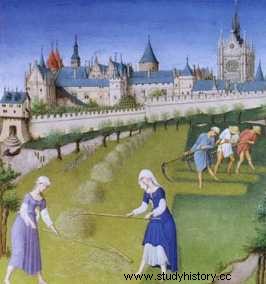
Introduction of fodder crops - The Very Rich Hours of the Duc de Berry (15th century)
A new type of plow
The great civilizations of the ancient world had developed in a hot environment, where the land was dry, friable and the soil shallow. The main problem for farmers then was to keep the soil moist for as long as possible. They adopted for this a light plough, without wheel, called plow , in reality a simple and solid stake barely scratching the ground. It was indeed useless to return the earth to the sun, it would dry faster. With a pair of oxen, the peasants plowed the field in parallel furrows, then, perpendicular to the furrows, so as to break up the clods of earth. This way of proceeding, adapted to the Mediterranean climate, was not at all suitable in Northern Europe. There, the ground was wet and heavy, moreover the humidity damaged the roots of certain plants. After several attempts, a new type of plow was adopted, still in use today. This plow, heavier than the plow was mounted on wheels. In front of the ploughshare, a long vertical iron knife, called a coulter, made it possible to make a first opening in heavy soil. The ploughshare, covered with iron, turned over the clods. It ended with a mouldboard which allowed the disturbed earth to be thrown out on either side of the furrow. In this way, between two parallel furrows, a small mound of earth was formed, which proved very useful. When the season was dry, the wheat grew in the hollow of the wet furrows. On the contrary, if the season was too wet, it grew on the mound cleared of excessive moisture.
Farmer using a plow pulled by two oxen
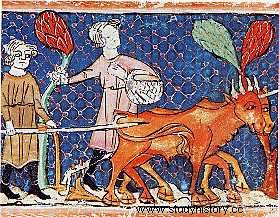
Plowing and sowing, Escurial (Royal Spanish Library)
More efficient couplings
Since the domestication of the horse, men knew that it was faster and stronger than the ox. However, this animal was only rarely used for field work, because the harness was not suitable for heavy traction. Traditional harnessing consisted of a loose breast band worn around the animal's neck. Also, the more the horse pulled, the more the collar interfered with his breathing. At the beginning of the Middle Ages, the rigid collar harness was invented. This padded collar rested on the horse's shoulders and did not impede its breathing. Team performance was also improved by changing the position of draft animals. In antiquity, two, four, sometimes six horses were harnessed side by side in front of a chariot. The strength of these horses was badly concentrated, and partly lost. In the Middle Ages, they were harnessed in a row, or in pairs, the horses thus exerted a much greater force. In hot, dry climates, horses' hooves wore relatively little. They were protected by wearing bandages called hipposandales . On the other hand, in the temperate and heavy climates of central Europe, the hooves were reinforced with irons nailed underneath. Shoeing was one of the innovations that contributed to making the horse the indispensable auxiliary of Man. In addition, the arched saddle improved the stability of the rider, especially in the longitudinal axis (front - back), it increased its capacity of maneuver in particular in the armed confrontations. The Barbarians from the East brought the stirrup from the 9th century. Connected to the saddle, the stirrups constituted a solid point of support, reinforcing lateral stability. The warrior could carry spears and stand in the stirrups in combat.
The mill
The rediscovery of the watermill
Today's industrialized world is grappling with a serious problem:that of energy. Until a few years ago, oil seemed sufficient to meet constantly increasing needs. We have since become aware of the depletion of resources. A similar problem arose during the eleventh century. Indeed, most of the energy available to humans was supplied by animals. The revival of economic activity created an urgent need for new energies. In Antiquity, the great empires had an enormous mass of slaves, so the question of energy never arose in a crucial way. But the decline of slavery in the medieval world, pushed men to rediscover and spread a very old invention:the watermill. It is thought that the first watermills were known, in the countries of the East, in Greece and in the Roman Empire from the 1st century BC. Around the 9th century, mills spread rapidly in France. The principle of the watermill is relatively simple. The force of water flowing or falling from above sets a large wheel in motion. Gears transmit this movement to a stone millstone which, moving on a fixed stone, grinds the cereals until it becomes flour. From this basic principle, ingenious devices made it possible to operate much more complex mechanisms.
| Waterwheel Applications | |
|---|---|
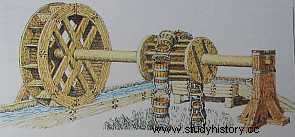 | A hub of the water wheel connected to a turnstile fitted with buckets, made it possible to bring water from flooded wells or mines to the surface. Thus, it was possible to irrigate unproductive dry land and to reactivate unexploited mines. |
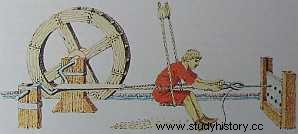 | This is a much more complicated application of the hydraulic system. A worker makes wire. The roughly worked metal is forced through small holes. Sitting on a swing, the worker grabs the wire coming out of the hole with large pliers. The swing is connected to a crank actuated by the hydraulic wheel, the worker is carried forwards then backwards along the axis of the crank. During the backward movement, he just needs to hold the wire with the pliers to pull it by force. This example bears witness to significant technical progress, since there is a transformation of the circular movement of the wheel into a back-and-forth movement. |
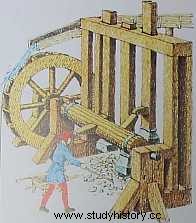 | Another decisive advance for the artisanal and industrial use of hydraulic energy came when a way was invented to transform the circular motion of the wheel into a rectilinear motion in the vertical direction. This is the camshaft:protruding wedges on the shaft connected to the wheel, rotating steadily, move the tool up and down which does the work.
These industrial uses explain why the mill was for a long time synonymous with factory and is still so in the English language (mill). |
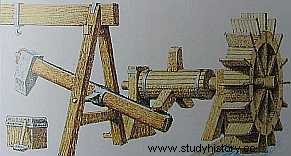 | |
Illustrations and texts "ALL THE UNIVERSE" (Hachette)
The miller's mill
- The stately mill :The oldest and most widespread of the mills was that of the miller, where the peasants came to grind wheat and other cereals. The lords forced their serfs to grind the grain, against payment, in the seigneurial mill (or ordinary mill), and punished those who used the hand mills. The use of the mill spread and the miller's house became one of the main meeting places of village life.
- The Windmill :At that time, the miller's mills were still hydraulic. But the Middle Ages had recourse to another source of energy:the wind. The use of the windmill imposed itself in arid and windswept environments. It has been known for a very long time, especially in Asia. The principle of its operation and its applications are practically the same as those of the water mill. The driving force is produced by the wind, which rotates wings connected to the central shaft. The most significant technical advancement occurred when the upper part of the mill was placed on a rotating platform. In this way the wings were oriented according to the direction of the wind.
Peasants plowing a field
We see, opposite, the different techniques used in agriculture, the harrow, the plow, the use of the horse, and in the background, we can see a windmill.
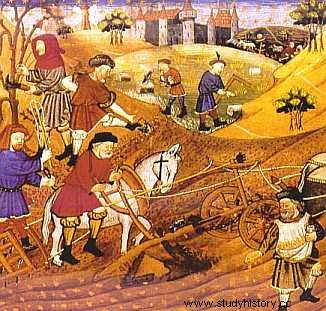
Other domains
Technical advances in navigation
The great medieval trade benefited from the progress made in the construction of ships and in the appearance of new instruments of navigation. The most important innovation was the diffusion of the compass . Its origin remains uncertain:if the Chinese had known it for a long time, it was perhaps the Arabs who introduced it to Europe, unless it was rediscovered by Western sailors or astronomers. The magnetic needle which simply floated, at the beginning, on water or on oil was, thereafter, fixed on a pivot making it possible to turn the compass in all the directions. Sailors could now face the high seas without fear of going off course. Besides the compass, we began to use the astrolabe (Arabic instrument), which made it possible to measure the height of the stars above the horizon. By calculating exactly the time spent sailing, one could accurately determine the distance the ship had traveled to the north or south (latitude), to the east or west (longitude). Taking advantage of these improvements, the Genoese were the first at the end of the 13th century to link Italy to Flanders and England by sea. At that time the typical ship was the galeasse . This galley moved mainly under sail. The appearance of the triangular lateen sail, which could be oriented in all directions, allowed the ship to sail in crosswinds and even against the wind. The stern rudder, fixed by hinges in the middle of the aft deck of the ship (stern rudder), replaced the side oars, long and heavy, maneuvers were improved. The yard (cross support of the sail) rotating allowed to direct the square sails to the side wind. On some sailboats, a second mast at the front was beginning to appear.
The Galeass
To navigate, Italian, French or Catalan sailors used the galleass. The length of the ship was three times its width, and the latter twice its height, this is the Catalan rule (tres dos ya as, "three, two, one"). In the Baltic Sea, the hourque was used instead, the hull of which was made of superimposed and not joined planks.
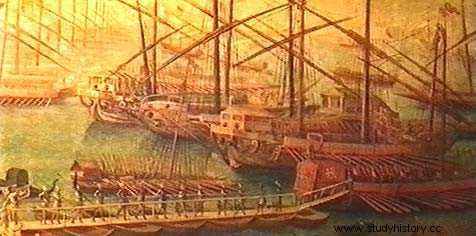
Progress in optics
Thanks to the rediscovery of works from Antiquity, or the discovery of the writings of Arab scholars, certain sciences experienced a great boom. So it was with optics. One of its applications would change the lives of many people:glasses. The first glasses are called besicles , derived from beryl, the transparent gemstone then used for glasses. They had no temples, but the frames of the glasses swiveled and pinched the nose to fix. It is likely that the use of concave and convex lenses, which increased the possibilities of the human eye, is much older. Didn't Emperor Nero use skillfully cut gemstones as magnifying glasses? Advances in optics also applied to navigation, and later to sky observation.
A cardinal copyist with his glasses
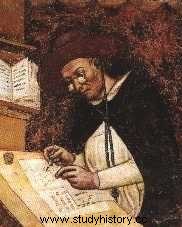
Tommaso da Modena (1352)
The first “printed” images
Culture has always been the business of a privileged few. Despite the efforts of the Church and enlightened rulers, learning to read and write was reserved for the privileged classes. It was understood that the others, the peasants, the artisans, had no need of it. Moreover, the very high cost of the manuscripts and their limited number limited the dissemination of the instruction. Two inventions would begin to change this state of affairs. The technique of wood engraving first, or xylography , a process already known in China:an image carved into the wood and inked left a clear imprint on a sheet. And the appearance of paper in the 14th century, allowing the replacement of parchments was an even more important advance. This is how drawn images illustrating scenes from the Bible were spread everywhere:they were called the "Bible of the poor", those who, not knowing how to read, were content to look at the illustrations.
The birth of chemistry
Medieval alchemists sought the substance, or philosopher's stone, that would turn any ordinary material into gold. We now know that this is possible in theory, thanks to atomic physics, but impossible in practice. However, medieval alchemists carried out thousands of experiments, often with a more mystical than scientific purpose, with the most disparate materials, then carefully recording the results of their observations. If they did not discover the philosopher's stone, they were able to know, through experience, the reactions of almost all substances and thus laid the foundations of chemistry.
The alchemist Nicolas Flamel
Legend has it that Nicolas Flamel not only discovered the formula for turning lead into gold, but also the elixir of eternal life. Nicolas Flamel would have reconstituted the philosopher's stone from the symbols contained in a book of divine origin:"Abraham the Jew". The alchemist had acquired a great fortune, and built several chapels and hospitals. In 1712, a traveler met a dervish in Asia Minor who told him that Nicolas Flamel and his wife were still alive. Some believe that Richelieu would have been the last owner of the book.
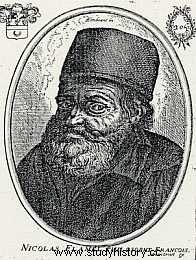
The exterior inheritance
- Gunpowder :The Chinese, inventors of gunpowder, used it to shoot fireworks during their parties, or to launch luminous messages at night. It is not known where and how gunpowder was introduced and “reinvented” in Europe. When its use spread in the 14th century, its experimentation was limited to the battlefields. Thus were born the first cannons, which projected, with a very approximate shooting accuracy, stone balls on enemy armies or against the thick walls of fortified castles which became obsolete.
- The invention of zero :The mathematical sciences also underwent a remarkable evolution in the Middle Ages. It is perhaps in these areas that progress has been most significant. Among the many innovations, we can recall the introduction of Arabic numerals, the very ones we use:in reality, these were Indian numerals transmitted to Europeans by the Arabs. A number that counts for nothing, zero, has an even greater importance, and considerably increased the possibilities of numeration. Merchant accounting improved and became more accurate.
The first industries
- The first textile industry :The textile industry was the basis of the enormous development that Europe would experience a few centuries later. The art of transforming sheep's wool or flax stalk into fibers, spinning them into continuous threads and weaving them into fabric is an activity that requires elementary technology. It is most likely for this reason that this work was the first to be almost completely “industrialized”. The rotary, rectilinear, or alternating motions that were imparted to the machine by the wheel of the watermill were well suited to the repetitive work of spinning.
- The birth of industries :After the year 1000, the situation was, schematically, the following:thanks to changes in political and social conditions, as well as to technical innovations, agriculture produced, in addition to what was necessary, surpluses, that is to say say, a wealth that could be traded or sold. The diffusion of the mills made it possible to have sufficient energy to actuate machines carrying out a series of works. Metalworking techniques were thus renewed, thanks to the additional amounts of energy provided by the mills. A waterwheel and camshaft, for example, could easily drive gigantic bellows in a foundry. The air sent to the fire raised the temperature to melting degrees, in large quantities and at limited blows. Metallurgical activities then experienced a real boom.
